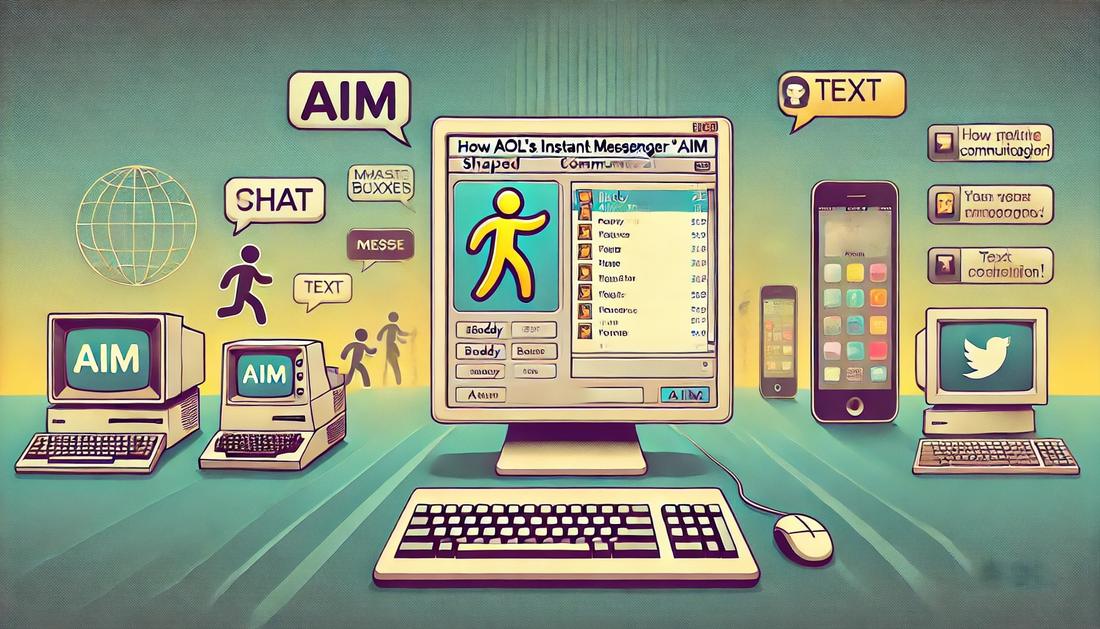AOL's Instant Messenger (AIM) didn’t just introduce a new way to communicate—it sparked a revolution in digital messaging.
Launched in 1997, AIM allowed users to send instant messages in real time, paving the way for today’s messaging platforms. Its impact on digital communication is undeniable, and there are many valuable lessons for startup founders looking to create the next disruptive platform.
This blog explores how AIM shaped early digital communication and provides actionable strategies for startups looking to replicate its success.
1. Seize the First-Mover Advantage
When AIM launched, it was one of the first widely accessible instant messaging platforms. By entering the market early, AIM built a loyal user base and became the default choice for digital communication, long before competitors emerged.
Takeaway for startups: If you’ve identified a gap or an untapped market, move fast. Being the first to market allows you to define the industry standard and establish a strong foothold before competition catches up.
2. Build a Product Around Simplicity
AIM was easy to use. Its minimalist design allowed users to log in, see a list of contacts, and start chatting immediately. There was no steep learning curve—AIM worked for both tech-savvy users and casual internet explorers.
Takeaway for startups: Simplicity is key, especially in the early stages. Build a product that users can grasp instantly. Avoid unnecessary complexity—focus on solving your user’s core problem with the least friction possible.
3. Create a Social Element
One of AIM’s most popular features was the “buddy list.” This list allowed users to see when their friends were online and ready to chat, fostering a sense of social connection. AIM wasn’t just a tool—it was a way to stay connected with your community.
Takeaway for startups: Building social elements into your product can drive engagement and retention. Whether it’s through friend lists, activity feeds, or user profiles, fostering connections between users can make your product an indispensable part of their daily lives.
4. Encourage Personalization
AIM allowed users to customize their profiles, away messages, and even fonts. This sense of personalization made the platform feel more like an extension of a user's personality, keeping people engaged and invested in their experience.
Takeaway for startups: Give your users ways to personalize their experience. Whether it’s through customization options, themes, or personalized recommendations, allowing users to make the product their own boosts engagement and loyalty.
5. Leverage Virality for Growth
AIM's viral growth was fueled by word of mouth. As friends started using the platform, they invited their peers to join. The platform’s communication-centric nature meant the more people that joined, the more valuable it became.
Takeaway for startups: Build virality into your product’s DNA. Create referral systems or make the product inherently more valuable when more people use it. Network effects can accelerate growth when done right.
6. Innovate with Features to Keep Users Engaged
Over time, AIM introduced features like group chats, file sharing, and even animated emoticons, keeping users engaged as the platform evolved. These features addressed user needs and kept the experience fresh.
Takeaway for startups: Don’t rest on your laurels. Continually innovate by adding features that align with your users' evolving needs.
Regular updates and improvements not only keep users engaged but also position your startup as a forward-thinking leader in the space.
7. Focus on Real-Time Communication
What set AIM apart from email and other communication tools at the time was its focus on real-time messaging. This instantaneous nature of AIM made conversations more dynamic and personal, creating a sense of immediacy that email couldn't match.
Takeaway for startups: Consider how real-time elements could enhance your product. Whether it’s live chat, instant notifications, or real-time updates, these features can create more engaging, immediate user experiences.
8. Monetization Through Ads Without Disrupting the Experience
As AIM grew, it began incorporating advertisements into the platform, monetizing its vast user base. However, it did so in a way that didn’t interfere with the core messaging experience, allowing the platform to remain free to users.
Takeaway for startups: When building a monetization strategy, focus on maintaining user experience. Whether through ads, premium features, or subscriptions, ensure your revenue streams don’t alienate your core audience.
9. Adapt to New Technology and Trends
Unfortunately, AIM struggled to keep up with the rise of mobile messaging apps like WhatsApp and Facebook Messenger. Its failure to adapt to the mobile-first world ultimately led to its decline.
Takeaway for startups: Stay agile and be prepared to adapt to emerging technology and consumer behavior shifts. The tech landscape moves fast, and startups need to be able to pivot or iterate quickly to stay relevant.
10. Foster Emotional Connections
AIM wasn’t just a tool—it became part of people’s lives. Whether it was reconnecting with friends, starting relationships, or communicating with family across distances, AIM had a profound emotional impact on its users.
Takeaway for startups: Build a product that resonates emotionally with your users. Products that tap into emotions—whether through nostalgia, connection, or empowerment—are more likely to build a loyal, engaged user base.
Conclusion: Replicating AIM’s Success
AOL’s Instant Messenger helped shape the digital communication era with its user-centric approach, simplicity, and viral nature.
For startup founders, AIM’s rise offers key lessons in product design, user engagement, and growth strategy. By building a simple, social, and personalized product, you can capture the hearts (and screens) of millions.
The digital landscape is constantly evolving, but the core strategies that AIM used remain timeless: focus on the user, innovate constantly, and be ready to adapt.
By applying these principles, your startup could be the next to revolutionize communication or any other industry.










